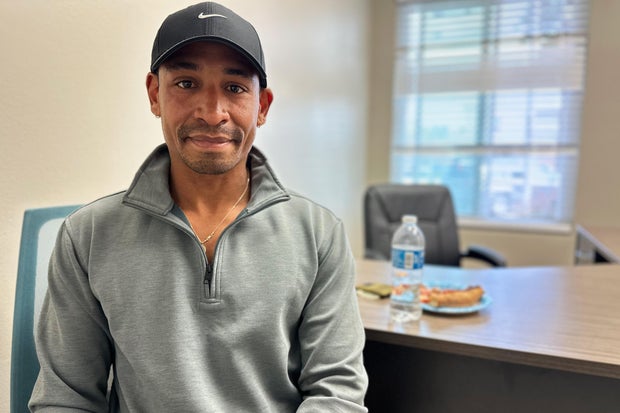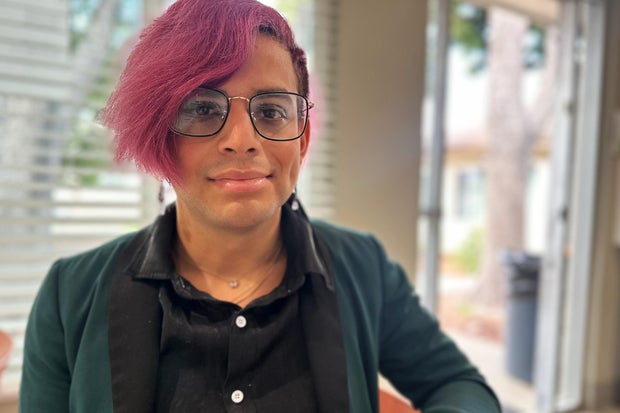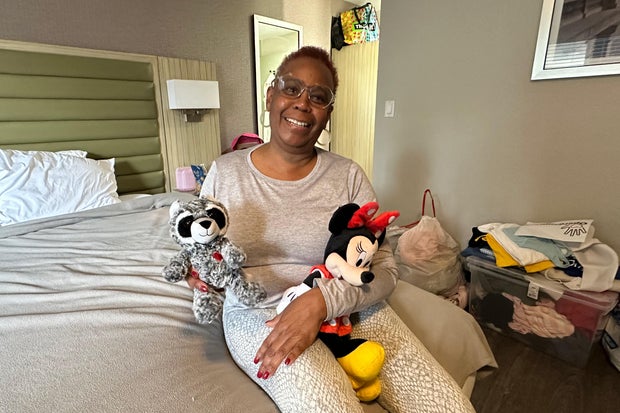ALTADENA, Calif. — As flames engulfed a nearby canyon, dozens of residents in a sober-living home fled to an unoccupied building about 30 miles south. The evacuees, many of whom were previously homeless, watched helplessly as their home burned on live TV.
When they awoke on air mattresses the next morning, loss set in. Some feared uncertainty. Others were jolted back to lives they thought they’d left behind.
“I had nothing but the clothes on my back. It just brought back all of those feelings of being homeless and a drug addict,” said one resident, Sean Brown. “Kind of like I was back at square one.”
The large two-story Altadena house, known to staff and residents as Art House, was surrounded by fruit trees and rugged mountains. For many, it was a safe space that enabled them to achieve and maintain sobriety, rebuild relationships, and hold down jobs.
Brown, 35, was among nearly 50 people displaced in January after the massive Eaton Fire destroyed one property and damaged another operated by the nonprofit Los Angeles Centers for Alcohol and Drug Abuse. Supported by public dollars, the organization provides housing and behavioral health treatment to people struggling with addiction, many who had been living on the streets. Operators say both properties are uninhabitable and that they are searching for permanent housing for those displaced.
Angela Hart/KFF Health News
“Our residents are still in temporary lodging. Right now we’re looking for something on an interim basis, but we still need to identify long-term housing for them,” said Juan Navarro, CEO of the nonprofit. “And we need even more beds. We’re seeing even bigger demand for treatment and services after the fires.”
In the weeks since one of the nation’s costliest natural disasters, it’s become evident that the Los Angeles wildfires have not only displaced people who had dug themselves out of homelessness and gotten into housing, but also dealt a blow to the region’s homelessness response. That far-reaching system of care formed by government agencies and local nonprofits has been buoyed by billions of dollars from the city, county, and state in recent years to combat California’s homelessness epidemic.
Now, wildfires are adding pressure to a system already under tremendous strain in getting chronically homeless people indoors. Homeless service operators and street medicine providers have been putting pressure on state and local leaders to allocate more funding to house people on the streets, but they are running up against competing demands for wildfire recovery — and tighter budgets.
“Many of the people we work with have already lost everything and they’re trying to rebuild their lives, and now there’s a whole other group of people doing the same thing and competing for the same resources,” said Jennifer Hark Dietz a licensed clinical social worker and the CEO of PATH, which provides services and housing for homeless people.
Angela Hart/KFF Health News
In recent years, state and local leaders have leveraged unprecedented investments to open thousands of shelters and temporary and permanent units. That’s helped Los Angeles County and the state notch meaningful gains, even as more than 187,000 people remain homeless in California, including 75,000 people across Los Angeles County.
The 2024 homelessness tally showed a 45% increase in the number of people who in the past year moved off the streets into permanent housing, and the number who moved from tents into temporary housing rose 32%, according to Va Lecia Adams Kellum, CEO of the Los Angeles Homeless Services Authority, which leads the countywide homelessness response system. That’s nearly 30,000 permanent housing placements across Los Angeles County.
And while homelessness rose 18% nationwide from 2023 to 2024, according to the most recent federal estimate, it increased only 3% in California. More strikingly, Los Angeles County reduced overall homelessness, albeit slightly.
The number of people living outside fell 5.1% in Los Angeles County, and in the city of Los Angeles, the number of unsheltered people dropped 10.4%.
That hard-fought progress is now in peril as the wildfires displaced tens of thousands of Los Angeles residents and destroyed more than 16,000 structures. Affordable housing, already in short supply, is being further strained.
Formerly homeless people who have experienced addiction, domestic violence, or mental illness now worry they won’t be prioritized for placements, despite losing their homes and qualifying for state and local homelessness initiatives to get people indoors. Many homeless people who have long waited for housing will be forced to wait even longer, as more displaced people face homelessness and compete for costly housing.
Homeless again
It’s unclear how many formerly homeless people are homeless again. Street medicine providers and other front-line workers say some are temporarily living in hotels, while others moved in with friends or family members.
There’s evidence that some have fallen back into homelessness.
“We’re already seeing some people have moved into their vehicles because they don’t have the money to pay for even temporary housing,” Adams Kellum said. “Before the fires, we were already seeing very vulnerable people unable to manage their rents, so this competition for housing puts people at even greater risk for homelessness.”
Adams Kellum said coordinating resources and services across a vast region has led to major progress but that more money is needed to help move people from short-term to permanent housing.
For now, residents of the burned-down Art House will be allowed to reside in an empty building in Santa Fe Springs that the nonprofit had planned to redevelop for residential treatment, Navarro said. He said the nonprofit is looking for more stable housing for those displaced but that rehousing them at Art House remains out of reach for now.
Residents grieve the loss of the Art House’s transformative setting, which they call an “empowerment campus.” Brown said that he has embraced that ethos, even as he has been displaced and remains traumatized by the wildfires. He is currently working two jobs and taking classes toward a bachelor’s degree.
Paul Rosales, a 24-year-old in recovery from meth, said Art House was a place of healing. “That’s where I found myself; it’s where I built my recovery. There was a beautiful orange tree, and the mountains were just a short walk away where you could meditate and watch the sunset.
Angela Hart/KFF Health News
“It was away from Skid Row. I knew I was safe,” Rosales said. “That’s all gone now.”
Residents say they’re grateful they aren’t on the streets, but anxiety grows by the day, especially for queer and transgender people who had formed a community there.
“It’s constant stress of not knowing if I’m going to be in a stable housing situation,” said Alexandria Castaneda, 29, who was addicted to meth but got sober after getting indoors.
Battle for resources
Sarah Hoppmeyer, chief program officer for Union Station Homeless Services, which provides housing for people on the streets, said she worries about dwindling resources. She and other providers stressed the importance of not overlooking people currently stuck in homelessness, many of whom have been waiting years for housing.
“We don’t want the wildfires to de-prioritize people who were already experiencing homelessness,” she said.
Elected leaders have pledged to preserve the gains Los Angeles County has made in reducing homelessness by allocating existing resources and demanding more. Several voter-approved initiatives in Los Angeles are critical, they say, but so too is lobbying for state support.
“Without continued and expanded support and resources, we risk losing ground” in reducing the number of people living on the streets, said Los Angeles County Supervisor Kathryn Barger, chair of the county board.
Angela Hart/KFF Health News
Previous massive fires have led to increases in homelessness, including in 2018 in Sonoma County and in 2024 on Maui, whose homelessness rate soared the year after fires.
State Sen. Sasha Renée Pérez, a Democrat whose district includes parts of Los Angeles County that burned in the wildfires, said she will continue pressing for additional homelessness funding as a member of the Senate budget committee. While Gov. Gavin Newsom’s administration says the state has plowed an unprecedented $27 billion into local homelessness response and prevention initiatives, he didn’t include any new money for battling the homelessness crisis in his proposal this year.
“Unfortunately, this year we didn’t see additional money being placed into that fund,” Pérez said. “But we have to keep making these investments.”
Newsom said Monday the state should not continue to “fund failure.” He said he is open to negotiations with cities, counties, and state lawmakers so long as any new homelessness funding comes with greater accountability, meaning that local governments use the money to clear encampments, dismantle tents, and reduce unsheltered homelessness.
Newsom officials stressed that the state budget is tight — it’s narrowly balanced and under greater strain than in previous years, with threats from the Trump administration and the potential loss of critical federal funding for programs such as Medicaid. The governor said he is “hopeful that we can land on an agreement,” but he warned the state could claw back funding if local governments aren’t adequately addressing street homelessness.
“We have been too permissive as it relates to encampments and tents. We need them cleaned up,” Newsom said. “We’re providing unprecedented support. Now we need to see unprecedented results.”
Assembly member John Harabedian, another Los Angeles-area Democrat, said additional homelessness spending is critical for wildfire victims and to continue combating the crisis statewide.
“Those folks who were already homeless, who just got into some sort of housing stability but then lost it again — they’re going to need immediate attention,” he said. “Our system is failing people.”
This article was produced by KFF Health News, a national newsroom that produces in-depth journalism about health issues and is one of the core operating programs at KFF — the independent source for health policy research, polling, and journalism. KFF Health News is the publisher of California Healthline, an editorially independent service of the California Health Care Foundation.






